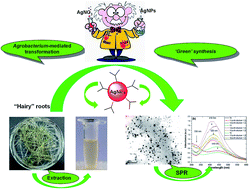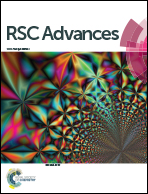‘Hairy’ root extracts as source for ‘green’ synthesis of silver nanoparticles and medical applications†
Abstract
The research was focused on the synthesis of silver nanoparticles (AgNPs) using extracts from the “hairy” root cultures of Artemisia tilesii Ledeb. and Artemisia annua L. The effect of operational parameters such as type of solvent, temperature of extraction, flavonoids concentration, and reducing power of the wormwood “hairy” root extracts on the particle size and yield of the resultant nanoparticles is reported for the first time. From the studied solvents, a water–ethanol mixture with a concentration of 70 vol% was found to be the best for the extraction of flavonoids from all “hairy” root cultures. The total flavonoid contents in A. annua and A. tilesii “hairy” root extracts were up to 80.0 ± 0.9 and 108 ± 4.4 mg RuE per g DW, respectively. Identification of flavonoids was confirmed by UPLC-ESI-UHR-Qq-TOF-MS analysis. Luteolin-7-β-D-glucopyranosid, isorhamnetin 3-O-glucoside, baicalein-7-O-glucuronide, apigenin-7-O-glucoside, quercetin, sitosterol, caffeoylquinic, galic, chlorogenic and caffeic acids were founded in the extracts. These extracts demonstrated the high reducing activities. Spherical, oval and triangular nanoparticles with effective sizes of 5–100 nm were observed. The TEM data revealed great differences in the shapes of NPs, obtained from the extracts from different root clones. The clustered and irregular NPs were found in the case of using ethanol extracts, mostly aggregated and having the size of 10–50 nm. The sizes of AgNPs decreased to 10–30 nm in the case of using aqueous extracts obtained at 80 °C. Biosynthesized AgNPs showed surface plasmon resonance in the range of 400–450 nm. The antimicrobial activity of the as-produced AgNPs was studied by disc diffusion method on Gram-positive (Staphylococcus aureus ATCC 25923 (F-49)), Gram-negative (Pseudomonas aeruginosa ATCC 27853 (F-51), Escherichia coli ATCC 25922 (F-50)) and Candida albicans ATCC 88-653 strains. It was found that the nanoparticles in some cases possessed the greater ability to inhibit microorganism growth compared to 1 mM AgNO3 solution. The colloidal solutions of the obtained AgNPs were stable in the dark for 12 months at room temperature. Thus, the A. annua and A. tilesii “hairy” root extracts can be used for obtaining of bioactive AgNPs.



 Please wait while we load your content...
Please wait while we load your content...